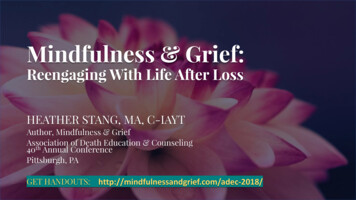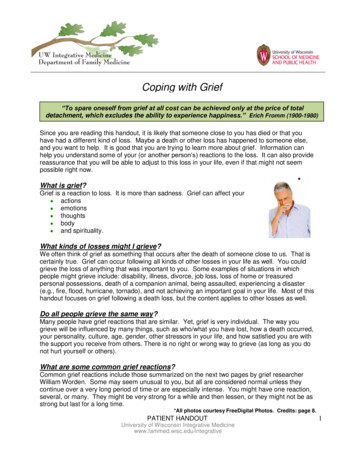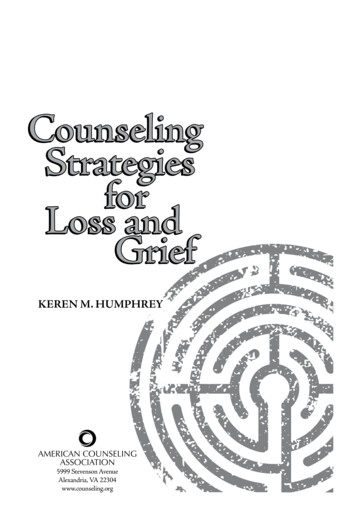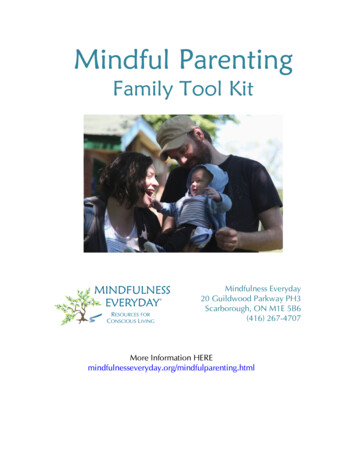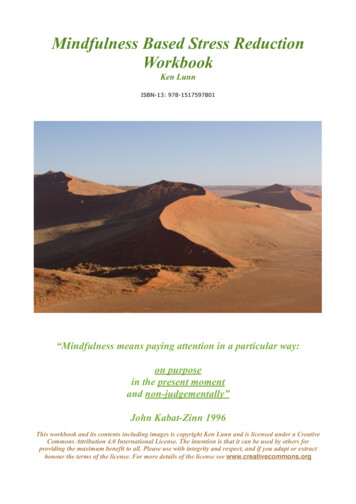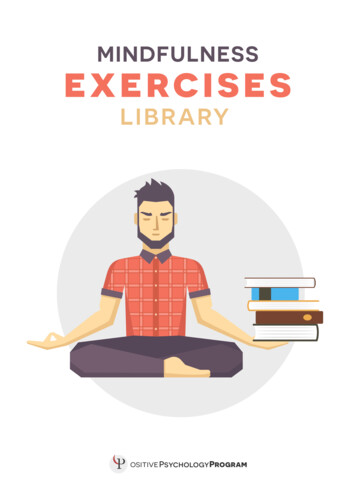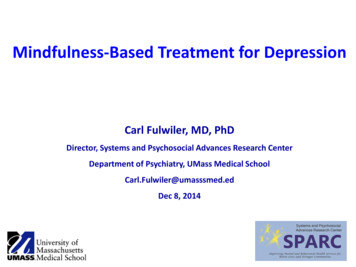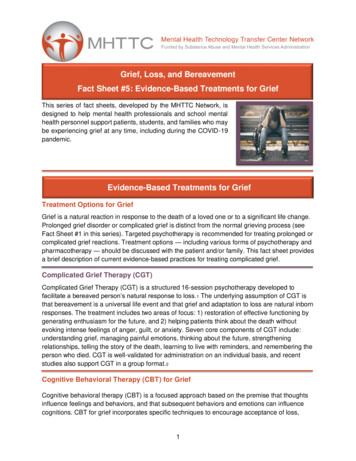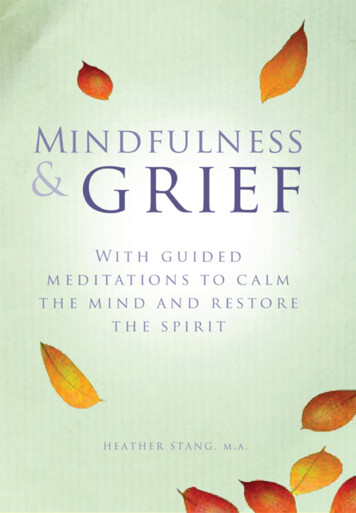
Transcription
Mindfulness&griefWith guidedm e d i t at i o n s t o c a l mYOUR mind and restoreYOUR spiritheather stang
Published in 2014 by CICO BooksAn imprint of Ryland Peters & Small Ltd20–21 Jockey’s Fields519 Broadway, 5th FloorLondon WC1R 4BWNew York, NY 10012www.rylandpeters.com10 9 8 7 6 5 4 3 2 1Text copyright Heather Stang 2014Design copyright CICO Books 2014The author’s moral rights have been asserted. All rights reserved. No part of thispublication may be reproduced, stored in a retrieval system, or transmitted in any formor by any means, electronic, mechanical, photocopying, or otherwise, without the priorpermission of the publisher.Neither the author nor the publisher can be held responsible for any claim arising out of theuse or misuse of suggestions made in this book. If you are in any doubt about your health,please consult your doctor before making any changes to your usual well-being regime.A CIP catalog record for this book is available from the Library of Congress and theBritish Library.ISBN: 978-1-78249-112-5Printed in ChinaEditor: Rosie LewisDesigners: Emily Breen and Geoff BorinFor digital editions, visit www.cicobooks.com/apps.php
ContentsIntroduction7The 8-Week ProgrammeWeek 1 Mindful AwarenessWeek 2 Conscious RelaxationWeek 3 Compassion and ForgivenessWeek 4 Skillful Courage13354967Stillness and Grace: Your Personal Daylong Retreat77Week 5 Getting UnstuckWeek 6 Meaning ReconstructionWeek 7 Allowing TransformationWeek 8 Perpetual ourcesIndexAcknowledgments141142144
In loving memory of Don and DougAllowThere is no controlling life.Try corralling a lightning bolt,containing a tornado. Dam astream and it will create a newchannel. Resist, and the tidewill sweep you off your feet.Allow, and grace will carryyou to higher ground. The onlysafety lies in letting it all in—the wild with the weak; fear,fantasies, failures and success.When loss rips off the doors ofthe heart, or sadness veils yourvision with despair, practicebecomes simply bearing the truth.In the choice to let go of yourknown way of being, the wholeworld is revealed to your new eyes.Danna Faulds, from Go In and In: Poems from the Heart of Yoga
INTRoDUCTION
Why I Wrote this BookMy meditation students often ask me if I am naturally calm. The answer is “no.”I discovered the practice of yoga and mindfulness meditation on orders from mynurse practitioner after being diagnosed with the stress-related illness shingles.“You need to do something about your stress,” she said. “It’s making you sick. Tryyoga.” I took her advice, sold my web development business, and after a few yearsof practicing yoga and meditation under the guidance of a wonderful group ofteachers, I earned my certification as a Phoenix Rising Yoga Therapy practitionerand mindfulness meditation instructor.The better I got to know myself through mindfulness practice, the more I knewI wanted to help others reduce their suffering, so I volunteered as a call specialiston a suicide prevention hotline. My uncle Doug died by suicide when I was seven.I had felt close to him and was surprised by his death—surprised that someone Iloved would kill themselves. My natural reaction was to try to make sense of it all.As a preteen I rummaged through my grandmother’s insurance files, found policereports, read books on suicide, and tried to learn everything I could about myuncle’s final days. As an adult, I was able to make use of that energy by helpingothers on the hotline. I would certainly rather have my uncle back, but given thatI cannot change what happened, my ability to make meaning out of the loss byhelping others has been incredibly rewarding.I developed an eight-week Mindfulness and Grief program for my privatepractice while I earned my Master’s degree in Thanatology (the study of death,dying, and bereavement) from Hood College in Maryland. Participants in myprogram have included people whose loved ones died from cancer, suicide, heartattacks, overdoses, car accidents, and murder.I am often asked how I can bear to witness this kind of pain regularly. Myanswer is simple: I get to see the pain of loss change people in miraculously positiveways. Over and over again I watch people transform from complete hopelessnessinto the positive states of mind called the Four Brahma-Viharas: loving-kindness,compassion, sympathetic joy, and equanimity. This does not happen overnight,but it does happen, and I count myself privileged to be part of that process.What is mindfulness?Simply put, mindfulness is the art of using your senses to be fully awake in thepresent moment. You may have noticed that most of your stress comes from8 I N T R O D U C T I O N
worrying about the past or fearing the future. For many of us, nothing provokesthis response more than grief.Few of us are taught how to cope with day-to-day stress, much less grief.Fortunately, anyone can learn how to turn the stress switch to “off,” even duringthe most troubling of times. You do not need to be a Buddhist, have a backgroundin mindfulness meditation or yoga, be physically fit, or subscribe to any particularset of spiritual beliefs to benefit from mindfulness.The only thing you need to approach your grief mindfully is yourself—justas you are, right now. The fact that you are reading this book shows that you havehope for your own ability to weather this storm. You will learn howmindfulness-based techniques can: Ease the physical symptoms of griefCalm your mind and help you to regulate difficult emotionsImprove your awareness of the present momentIncrease your compassion toward yourself and othersHelp you to make meaning from your lossDevelop your new self-narrative for moving forward.Posttraumatic GrowthThe good news is that not only do people survive grief, but many emerge on the otherside changed for the better. This phenomenon, described as “posttraumatic- growth”by Lawrence G. Calhoun and Richard G. Tedeschi of University of North Carolina,Charlotte, applies to any major life event—including grief—that challenges youremotional balance, beliefs, and personal narrative (2006.)Right now, the concept of adapting to your loss, let alone transforming yourlife in a positive way, may sound far-fetched. However, if you follow themindfulness practices offered in this book, you will experience, breath by breath,a subtle but profound shift in your world view.The reality is that when you have worked through your grief you will not bethe same as you were before your loss; you will not be the same as you are now.Changes will occur with or without mindfulness in your life, and while you wouldrather have your loved one back, I imagine that since you are probably feeling ahigh level of distress, it may be helpful to know that on the other side of grief youmay experience the following benefits:I N T R O D U C T I O N9
Improved self-perceptionSense of strengthOpenness to new possibilities Improved level of compassionBetter relationships with others.Grief, after all, is not a pathology or an illness. It is a natural part of life that causesus to experience suffering. Since the goal of mindfulness practice is the cessationof suffering, it can only make sense to bring the two together.A key element of grief-work is reconstructing your personal story. Themindfulness practices will help you to move forward through your experience ofloss while creating a continuing bond with the person you will always love.How to Use this BookFor the next eight weeks you will be introduced to a new theme in each chapterthat includes supportive meditation and journaling exercises. It is suggested thatyou set aside 20 to 90 minutes each day to practice. There is also a daylong retreatscheduled between weeks 4 and 5. You may want to clear your schedule or arrangea day off ahead of time at this stage, if you would like to carry out the retreat.Feel free to move through the book sequentially, or repeat the same topic againand again until you are ready to move to another section Read through each exerciseonce or twice before you try it for the first time. You can also download audio versionsof key exercises at www.mindfulnessandgrief.com. Each week may include: Mindfulness meditation to teach you how to approach each moment withawareness and compassionGuided relaxation to help your body benefit from the relaxation response,which will restore your health and calm your mindGentle stretching to help you increase flexibility, build strength, and feelmore at home in your bodyMindful journaling and expressive arts to help you express your feelingswithout judgment, while at the same time externalizing your “story” so thatyou can witness it with compassion Contemporary theories of grief to put mindfulness practices in the contextof the modern understanding of adapting to loss.10I N T R O D U C T I O N
Week 1Mindful Awareness: How to Find Refuge in the Present Moment will show you howyour breath and body can be your safe harbor when you are overwhelmed orunsteadied by grief.Week 2Conscious Relaxation: How to Care for Your Grieving Body will teach yourelaxation techniques that will help you to release tension and steady your mindafter a loved one has died.Week 3Compassion and Forgiveness: Attending to Grief with Loving-Kindness will guideyou through meditative practices that will open a closed heart and engage thehealing power of loving-kindness towards yourself and others.Week 4Skillful Courage: The Dance of Strength and Vulnerability will help you cope withthe rollercoaster of grief as you move up and down between hope and despair.Daylong Retreat: Your Personal Daylong Retreat gives you a “day off ” from tendingto others and an extended period of time to practice and deepen your newfoundmindful awareness.Week 5Getting Unstuck: Tending to the Five Mental Hindrances will show you how tomeet resistance with curiosity and transform barriers into opportunities forpersonal growth and awakening.Week 6Meaning Reconstruction: Learning to Live After Loss will explain how the processesof sense making and benefit finding will help you honor your loved one’s legacywhile continuing your own life’s journey.Week 7Allowing Transformation: Who Am I Now? will help you to rewrite yourpost-loss narrative and tap into the power of meaning-making in spite ofuncertainty and change.I N T R O D U C T I O N11
Week 8Perpetual Mindfulness: Practicing Beyond Grief will help you to developa relationship with your practice so that you can live your life with equanimityand transcend common “practice pitfalls.”As you work through each chapter, be gentle with yourself. There is no right orwrong way to practice. Remember that your intention in starting this mindfuljourney is to reduce suffering, and while there may be times when unpleasantfeelings arise, always treat yourself with loving-kindness. Look deeply when it feelsright; back off when it feels right. Know that just showing up is enough.There are many losses in life: separation, divorce, unemployment, health-relatedlosses, foreclosures, relocations—the list goes on. Readers experiencing loss otherthan the death of a loved one will also find the practices suggested in Mindfulnessand Grief helpful.All SpirituaLITIES WELCOMEI use Buddhist psychology and the teachings attributed to Siddhartha Gautama,the historical Buddha, to illustrate how mindfulness can alleviate suffering. It isimportant to recognize that you do not need to believe in the Buddha or be aBuddhist to benefit from these practices. Mindfulness does not require faith; itrequires only practice. No matter what your spiritual beliefs, you will findsomething useful in each weekly practice.My Aspiration for YouIt is my hope that mindfulness will help your body to return to a state of balancewhile honoring your grief process. I also hope these practices will be a place you cancall home for the rest of your life, and to which you will be able to return again andagain to grieve, to love, to celebrate, and to heal. The next time your world isuprooted, you will know you have what it takes not only to survive, but also to thrive.With metta,Heather Stang, M.A.12I N T R O D U C T I O N
Week 1MindfulAwarenessHow To Find Refuge in thePresent MomentWhen the heart grieves over what it has lost,The spirit rejoices over what it has left.SUFI EPIGRAM
Grief and TransformationMindfulness and grief contain the seeds of transformation. Grief forces you tochange by assigning you unexpected roles, removing the physical, emotional, andmaterial resources you once had, and changing your assumptive world into anunfamiliar landscape. Mindfulness allows you to make the most of this newterritory by introducing you to the self you are in the process of becoming throughyour senses. As you reacquaint yourself with your spirit by slowing down andturning your focus inward, you will hear the whispered wisdom of your true self,which has long been forgotten and can now be remembered.UNDERSTANDING MINDFULNESSOn the first day of the Teaching Advanced Meditation Techniques program at theKripalu Center for Yoga & Health in Stockbridge, Massachusetts, Sudhir JonathanFoust walked into the room and explained the concept of mindfulness based onan original teaching demonstration by Chogyam Trungpa. He drew a V shape ona very large pad of white paper. “What’s this?” he asked. We all agreed it must be abird, and eagerly shouted out our response. He smiled and paused for a moment.“Sky, with bird,” he said.That is what mindfulness is. It is seeing the sky and the bird with an equalamount of attention, and no desire to change either one. If we skillfully apply thisprinciple of mindfulness to grief, it means we observe the fullness of ourexperience: our heartache and love and fear and anger and our gratitude for thefriend with the casserole, and whatever else shows up.It means shifting from an “either/or” point of view to the inclusive state of“and,” or what some teachers describe as a “this, too” state of mind. When youlearn to make this gradual shift you will be on your way to freeing yourself fromwhat feels like an endless cycle of suffering, and while pain will still exist, you willcome to learn that just like pleasure, suffering too is impermanent.So, rather than fight against reality, we learn to embrace each moment withmindful acceptance. Acceptance is a loaded word; when used unskillfully it makesus feel unseen, unheard, and demoralized. If you have ever been told to “buck up”or “get over it,” you know how this feels. This kind of acceptance is not onlyunhelpful, but also makes us feel small.14W E E K1M I N D F U LA W A R E N E S S
Understanding AcceptanceAcceptance in the mindful context means that even when the unthinkablehappens, we honor our self and our experience with dignity and kindness. Ratherthan turn our back on our own suffering, we treat ourselves as we would a belovedfriend. We take the time to pay attention to the physical sensations, thoughts, andfeelings that accompany our pain.This kind of acceptance means that we choose thoughtfully how to respond,and temper our response with compassion. We know we do not need to numbour pain or run from reality, nor do we need to punish ourselves through blame,guilt, self-loathing, and a sense of unworthiness. We find a middle ground in openawareness, just as the Buddha found peace in the Middle Path.Before we dive into how you can practice mindfulness yourself, it may be helpfulto understand where these practices come from. While mindfulness and meditationcertainly existed before the historical Buddha, it is his teachings that brought thesetechniques to those of us who were not on a dedicated spiritual quest.The Story of the BuddhaThe Buddha was born Prince Siddhartha Gautama, the heir to a small kingdomin the foothills of the Himalayas. A sage predicted that the young prince wouldgrow up to be either a great ruler or a great spiritual teacher. His father, the king,wanted Siddhartha to be a great ruler like himself, and took extreme measures tosurround his son with all the luxuries money could buy so that he would not wantto leave the palace.When Siddhartha was of age, he married a beautiful princess, and togetherthey had a son. However, when Siddhartha reached the age of 29, something insidehim became restless. For the first time in his very privileged and sheltered life, heleft the royal compound. In that fateful first visit to town he witnessed sufferingfor the first time: First he saw an old man Then a sick manLastly a corpse.T H ES T O R YO FT H EB U D D H A15
Surprised, the young prince asked his chariot-driver: “Who becomes afflicted likethese people?” The chariot-driver, Channa, replied, “Everyone.”Siddhartha left the palace a second time, and encountered a wandering ascetic,a spiritual man. The prince asked his chariot-driver: “Who is that?” Channaexplained, “That is a man seeking truth and liberation; he has left worldlythings behind.”Prince Siddhartha was so inspired that he left his wife and child in the care ofhis family and became a wandering ascetic himself. He meditated, practiced yoga,and ate very little for six years. Homeless, sick, and nearly starving to death,Siddhartha realized that a life of renunciation was not getting him anywhere closerto the truth.At this realization, he accepted a mixture of milk, rice flour, and honey ina golden bowl from a young maiden. This act of self-indulgence angered the fiveascetics with whom he was traveling. Untouched by their disdain and recognizingthe golden bowl as a sign of impending Buddhahood (as it was well known at thetime that all previous Buddhas had eaten from a golden bowl,) Siddhartha satdown under the Tree of Enlightenment, the Bodhi Tree. He vowed not to stopmeditating until he reached perfect enlightenment—Nirvana.As dusk fell, the great demon Devaputra Mara appeared and conjured up manyvisions to distract Siddhartha from his aim. However, none of his tactics workedand, enraged, the demon finally demanded: “Who are you to seek enlightenment?Who will testify that you are worthy of perfect enlightenment?”Siddhartha reached down with one finger and touched the earth. “The earthis my witness,” he said. The story goes that the world shook with such vigor thatMara and his demon army fled in fear. Able to calm his own internal demons andsteady his mind, Siddhartha finally achieved enlightenment and became theBuddha, the “awakened one.”After his enlightenment, the Buddha could see that all people wanted to behappy, but most did not know the way. He could see that everyone had BuddhaNature inside, but most did not realize it. Overcome with compassion, he decidedto share what he had learned with the world, and spent the rest of his life teachingwhat is known as dharma, or truth.16W E E K1M I N D F U LA W A R E N E S S
The Four Noble Truthsand the End of SufferingThe Buddha’s first lesson is known as the Four Noble Truths. It details the causesof suffering and gives instructions for ending suffering.The First Noble Truth acknowledges that pain, or dukkha, exists. We will all bedisappointed, experience loss, and be unsatisfied at some point in our lives,no matter how hard we try to avoid it. In short, we will encounter pain just as weencounter pleasure. Pain in this context refers to an inevitable and uncontrollableevent, such as the death of a loved one or an illness.The Second Noble Truth says that suffering exists because of our attachmentto cravings, aversions, and a false sense of security. Suffering in this context is ourreaction to pain, which is often unskillful. We hold on tightly to sensory pleasures,opinions, rituals, and the belief that everything is permanent, when in realityeverything is fluid.The Third Noble Truth gives us the good news: we can end our suffering andachieve a state of peace in which we will be untouched by the forces of greed,hatred, and delusion; the root causes of suffering.The Fourth Noble Truth tells us that the way to end our suffering is throughthe Noble Eightfold Path. This involves living our life with right understanding,right thought, right speech, right action, right livelihood, right effort, rightmindfulness, and right concentration. The lesson is that neither self-indulgencenor self-denial will lead to peace, and it is called the Middle Path.Charting your OwnMiddle Path through GriefLet’s look at how the Middle Path and the Four Noble Truths can help you to workthrough your grief. When a loved one dies, you come face to face with the FirstNoble Truth: pain exists. You realize how temporary life is and recognize that atany moment everything you “know” to be true can suddenly fall apart. It feels asthough there is no ground beneath your feet. Some of us become preoccupiedwith our loss, while others try to avoid thinking about it altogether by numbingour pain with food, drugs, or alcohol. This is the Second Noble Truth in action:suffering comes from clinging and aversion, or obsession and avoidance.C H A R T I N GY O U RM I D D L EP A T HT H R O U G HG R I E F17
The Third Noble Truth promises the end of suffering, which gives us hope in theface of great pain. This leads us to the practices offered in the Fourth Noble Truth.It is often said that if you follow just one of the practices suggested in the NobleEightfold Path, the other seven will naturally show up in your life, so let’s beginwith right mindfulness.Even in the absence of grief, the practice of mindfulness may seem daunting.If you have ever picked up a magazine with a meditating model smiling with blisson a beach, you will know what I mean. However, the truth is that a moment ofmindful peace is not as far away as you might think, and just that one momentcan imbue your whole being with hope. I see this happen regularly in grief groups,and all it takes is focused attention on your breath and your body.Mindfulness lets you expand your view by placing you in the middle groundbetween denying your pain and overindulging in your suffering. From that vantagepoint you can observe the whole experience with a sense of openness to whateverarises. You stay in contact with the entire scope of your existence, and youexperience grief without becoming grief itself.The first step to practicing mindfulness is to understand that there is no rightway to grieve. You may have been told that you will grieve in stages, butcontemporary grief research shows that there is no single “right way” to grieve.The fact is that each of us experiences grief in our own way. Your reaction to lossis determined by a combination of factors: The nature of your relationship with the person who died The way they diedYour physical healthYour life circumstancesLearned coping strategies Your ageAvailable social and economic support (or lack thereof.)Most people experience uncomfortable physical sensations, emotions, thoughts,and changed behavior, but no two people are identical. You may find thatrelationships increase in intimacy or dissolve completely. Religious or spiritualpractice will either provide you with comfort or seem inadequate as you try tomake sense of the loss. No matter what happens, if you learn to be mindful of yourexperience you can learn to respond rather than react.Mindfully relating to your grief means being fully aware of your experience ofloss while simultaneously embracing whatever arises in you with compassion and18W E E K1M I N D F U LA W A R E N E S S
loving-kindness. This does not mean that you have to be happy despite your loss.It means that instead of fighting a losing battle against something you cannotchange, you observe the situation in order to develop wisdom and reduceyour suffering.The Chinese symbol for mindfulness is a combination of the symbols for “now”and “heart.” This sums it up perfectly: mindfulness is the practice of opening yourheart to what is happening right now. Openness is compassionate and caring: holdingthe moment in a tender embrace rather than attacking it with hatred and violence.I like the notion of “calm abiding.” One of my meditation friends loves theexpression “to be with” what is happening. Mindfulness teaches us that we don’thave to fix, label, or judge what arises. In fact, most of the time trying to fix thesituation is useless. Instead, we learn how to respond to a situation withoutreacting; this gives us an amazing amount of freedom, and helps us to get unstuck.We are born mindful and curious, but as we grow we are influenced by othersand by our own experiences. Everything, from how we potty-train to what typeof food we like, is labeled “good” or “bad.” We stop noticing things “just as theyare,” and instead we begin to make snap judgments on autopilot. In this way welearn to chase after pleasure and push everything else away. We create a story about“how things are supposed to be.” We tell ourselves why we deserve or don’t deservewhatever is happening to us, when so often what is happening isn’t personal at all.Unfortunately, most of us become cut off from our true nature, deny reality, andnever feel that we are quite fully alive.The death of a loved one moves the autopilot switch to “off.” This is a wakeupcall—a bell of awareness—an opportunity to intentionally change course. At firstyou may feel numb. This is normal. It is the body’s graceful way of helping youcope in the early days of loss. Eventually you will realize that you need to reroute,but you may not be sure where to begin; this is where mindfulness can help. If youthink of your life as a journey, the present moment is the “You Are Here” markeron the map. No matter how disoriented you feel, your mindfulness practice willhelp to bring you back to the safe harbor of the present moment using the toolsyou already have; your breath and your body. You can then make the choice toleave the autopilot switch set to “off,” and instead chart your own course.C H A R T I N GY O U RM I D D L EP A T HT H R O U G HG R I E F19
How to Begin YourMindfulness PracticeMindfulness begins with the assumption that everything is already okay, and thatwe have just forgotten what “okay” is. Remembering our true nature is especiallydifficult after a significant loss. Do you feel that everything is okay right now?Probably not. In fact, I wouldn’t be surprised if you are asking yourself, “How canI ever get from here to okay?”The answer is that we are going to take baby steps. Some days they will be reallytiny baby steps, where just walking across the room to sit on your meditationcushion is like climbing Mount Everest barefoot with a monkey on your back.Other days you will surprise yourself with a baby leap as you find peace in therhythm of your own breath for a few precious moments. Eventually you will wakeup one morning and realize that you slept through the night for the first time, oryou will eat a meal and find yourself enjoying the taste of the food.Remember: it does not matter if you were naturally calm and healthy beforeyour loss, or if you were always on the go and never thought twice about relaxation.We are going to start from where you are now, and consider the possibility thatone day you will look over your shoulder to where you have come from anddiscover that the accumulation of baby steps (and baby leaps) has delivered yousafely to the other side of the canyon of grief.What to expect from your practiceThe first time you reconnect with your body you may feel as though you are meetinga long-lost friend. The reconnection may be bittersweet, but as you learn to payattention to the present moment you will move beyond the story of who you thinkyou are, and open yourself to satya, or truth. Yes, you feel devastated, lost, vulnerable,and confused, but you are still intact. The truth is that you are not destroyed.This book isn’t going to tell you how to use mindfulness to “get over” yourgrief. That is because grief-work isn’t about getting over anything. It is aboutlearning how to adapt to your life after loss, and finding a new way to relate toyour loved one even though they are no longer physically present. I am not goingto tell you how to “fix” yourself, because nothing is actually wrong with you. Fornow, if you find you are chastising yourself for your thoughts, feelings, and actions,and believing that you should be over this already, remind yourself that you arehuman, and that your pain is an artifact of love.20W E E K1M I N D F U LA W A R E N E S S
Two types of mindfulness practice:formal and informalThe main way to practice mindfulness is through meditation, which is typicallydone seated on a meditation cushion on the floor. A stack of blankets works fine,too, or you can practice in a straight-backed chair.This is considered formal practice because you dedicate a set amount of timeto practice “on purpose.” Formal mindfulness practice is like weight lifting—itbuilds your “mindfulness muscles” so that when a stressful situation arises in theso-called real world, your mind and body are prepared to return to a state ofequilibrium. Just as showing up at the gym regularly to work out increases yourfitness over time, sitting on your meditation cushion regularly increases yourability to remain calm during the storm.Another type of formal practice is walking meditation, where you set aside anamount of time to walk with nowhere to go. This is covered in depth in Week 4.Spontaneous awareness:informal mindfulness practiceThe mindfulness skills that we build in formal practice can be taken out into theworld through informal practice. This doesn’t mean that you have to plunk yourcushion down in the middle of the mall, of course. Informal practice is an internaland spontaneous act, such as silently sending loving-kindness to people ona crowded bus, or paying attention to the sensations of your body while standingin line at a grocery store.I had one student choose the longest checkout line in order to practicemindfulness of the sensation of patience after
mindfulness practices offered in this book, you will experience, breath by breath, a subtle but profound shift in your world view. The reality is that when you have worked through your grief you will not be the same as you were b
